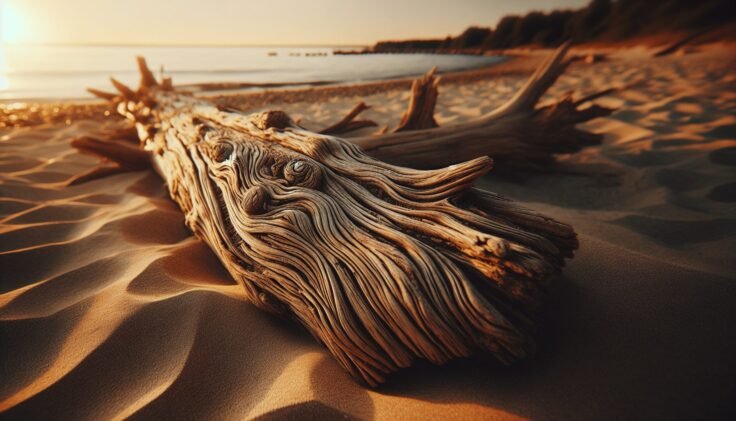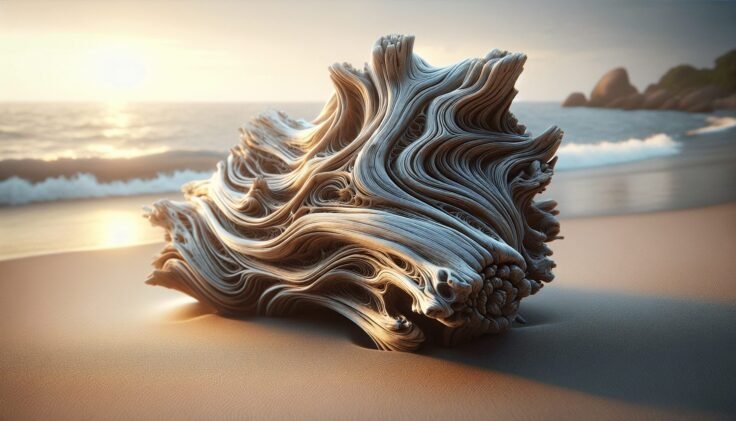Have you ever walked along a beach and found yourself captivated by the twisted and worn pieces of wood scattered along the shore? These sun-bleached wonders, known as driftwood, hold stories of their own adventures at sea. In this article, “Driftwood Close Up,” you will discover a new appreciation for these maritime treasures as we explore their origins, transformations, and uses.

What is Driftwood?
Driftwood is any wood that has been washed onto a shore or beach of a sea, lake, or river by the action of winds, tides, or waves. It’s not just ordinary wood; each piece of driftwood has a narrative embedded in its fibers. From mighty trees that have stood for decades to branches carried far from their original homes, driftwood is nature’s storyteller.
The Journey to Driftwood
Imagine how a once-towering tree becomes driftwood. It begins as a regular piece of timber, rooted in forested land or beside a riverbank. Over time, external forces such as storms, flooding, or erosion cause the wood to break free and enter a watery voyage.
- Origin: The journey starts when wood breaks off from a tree due to environmental factors.
- Transport: Water currents and waves transport the wood through various waterways.
- Transformation: As it travels, the wood weathers, softening its surface and reducing sharp edges.
Driftwood’s journey is a study in persistence and adaptation, enduring harsh conditions to emerge as unique artifacts.
How Does Driftwood Form?
Driftwood is more than just debris; it undergoes a fascinating transformation process. This section will explore the physical changes that occur as wood becomes driftwood and the environmental factors influencing these changes.
Weathering and Erosion
Weathering and erosion are key processes in the formation of driftwood. As wood is carried through water, it faces continual exposure to various natural elements. The relentless interaction with water and sand smooths its surfaces over time.
Chemical Changes: Water dissolves soluble substances in the wood, contributing to its light weight and buoyancy.
Physical Changes: Continuous abrasion by sand and contact with other objects leads to the smoothing of wood’s edges.
The Role of Marine Life
The sea is teeming with life, and marine organisms play a significant role in changing wood into driftwood. Barnacles, mollusks, and other organisms attach themselves to the wood, not only altering its appearance but also adding to its unique texture.
Fungus and Bacteria: They break down the cellulose in the wood, which makes it softer and more pliable.
Invertebrates: Their burrows and marks leave distinctive patterns on the wood.
The interplay between these biological and mechanical forces creates the driftwood’s distinct character.
Driftwood Species and Characteristics
Driftwood can come from a variety of tree species, each contributing its own traits to the finished piece. Let’s look at some common types of driftwood you might encounter and their specific characteristics.
Common Types of Driftwood
Pine Driftwood: Known for its light color and soft texture, pine driftwood often has a smooth finish due to its fine grain.
Oak Driftwood: Because of its hard texture, oak is less common as driftwood, but when found, it has a distinct grey to silver hue.
Cedar Driftwood: It is resistant to rot, making it durable under seawater, with a rich reddish hue.
Bamboo: Commonly found in tropical areas, it is recognized for its hollow interior and light weight.
Identifying Driftwood Characteristics
The following table illustrates how to identify driftwood from different types of wood:
| Characteristic | Pine | Oak | Cedar | Bamboo |
|---|---|---|---|---|
| Color | Light | Grey/Silver | Reddish | Light |
| Texture | Soft | Hard | Medium | Hollow |
| Grain | Fine | Coarse | Uniform | N/A |
| Resistance to Water | Moderate | Low | High | High |
Understanding these characteristics allows you to appreciate the diversity and beauty of driftwood found in different environments.
Environmental Impact of Driftwood
Driftwood is not just a whimsical beachside curiosity; it plays important ecological roles in coastal and aquatic ecosystems. Let’s examine the positive impacts of driftwood on its environment.
Habitat and Shelter
Driftwood provides essential habitats for numerous animal species. Birds, insects, and marine life find shelter in or around driftwood pieces.
- Breeding Grounds: Birds use driftwood as nesting sites.
- Marine Shelter: It offers hiding spots for small fish and invertebrates.
Erosion Control
Driftwood helps in stabilizing sand dunes and reducing coastal erosion. When large pieces of wood anchor on the shore, they prevent the shifting of sands, supporting vegetation growth and preserving the coastline.
Nutrient Cycling
Driftwood decomposes over time, returning nutrients to the ecosystem. The breaking down of organic matter enriches the soil and waters, promoting plant growth and sustaining marine life.

Creative Uses of Driftwood
If you are fascinated by the aesthetic appeal of driftwood, consider its potential in art and design. Driftwood’s natural beauty lends itself to a variety of creative applications. Explore some popular uses of driftwood in your home and garden.
Home Decor
Driftwood can be an eye-catching feature in interior design. Its rustic charm complements various decor styles, from modern minimalist to coastal themes.
- Wall Art: Create unique wall hangings or frames using pieces of driftwood.
- Furniture: Design tables or chairs that incorporate driftwood for a natural touch.
- Lighting: Enhance your space with driftwood lamps or chandeliers.
Garden Enhancements
Incorporating driftwood into your garden can create an enchanting landscape. It can serve both decorative and functional purposes.
- Borders and Edging: Use driftwood logs to define garden paths or flower beds.
- Plant Supports: Allow climbing plants to twine around robust driftwood stakes.
- Water Features: Create rustic fountains or ponds encircled by driftwood.
Embrace your creativity and let driftwood inspire new projects around your home and garden.
Collecting Driftwood
If you plan to gather driftwood for personal use, it’s essential to familiarize yourself with the guidelines and best practices for collecting driftwood responsibly.
Legal Considerations
Before you start collecting, check local regulations and laws regarding the removal of driftwood. Some areas protect driftwood for ecological reasons, and removing it without permission can lead to fines.
Safety Tips
Ensuring your safety while collecting driftwood is important. Here are some precautions you should take:
- Wear Gloves: Protect your hands from sharp edges and splinters.
- Check Tides: Collect during low tide to avoid being caught in rising water.
- Inspect Wood: Be mindful of insects or sharp objects embedded in the wood.
Sustainable Collection
Be mindful of the environment when collecting driftwood. Take only what you need and avoid disturbing wildlife or damaging habitats.
- Leave some behind: Ensure enough driftwood remains for natural functions and habitats.
- Minimal Intrusion: Tread lightly and respect the surrounding ecosystem.
By following these guidelines, you can collect driftwood sustainably, preserving its beauty and ecological role for others to enjoy.
Conclusion
With its captivating history, ecological significance, and artistic potential, driftwood is truly a marvel of nature. By taking a closer look at driftwood, you uncover stories of transformation, resilience, and beauty that inspire awe and creativity. Whether you’re drawn to its natural beauty, fascinated by its ecological roles, or eager to incorporate it into your art and decor, driftwood offers endless opportunities to appreciate and interact with the natural world around you.